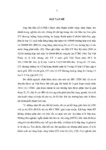
Please use this identifier to cite or link to this item:
http://dulieuso.hmu.edu.vn/handle/hmu/1852| Title: | Nghiên cứu điều trị ung thư biểu mô tế bào vẩy vùng đầu cổ giai đoạn III, IV (M0) bằng hóa xạ trị tuần tự |
| Authors: | Trần Bảo, Ngọc |
| Advisor: | PGS.TS Đặng Tiến Hoạt PGS.TS Bùi, Diệu PGS.TS Bùi, Diệu |
| Keywords: | 62720149;Ung thư |
| Abstract: | Nghiên cứu tiến hành can thiệp điều trị cho 115 bệnh nhân ung thư vùng đầu cổ giai đoạn III, IV (M0) bằng liệu trình hóa xạ trị tuần tự: hóa trị tấn công (phác đồ Taxanes, Cisplatin và 5-FU) 2-3 chu kỳ, sau đó hóa xạ trị tuần tự (xạ trị gia tốc, hóa trị ngày 1, 22, 43 bằng Cisplatin) với các trường hợp có đáp ứng sau hóa trị tấn công tại Bệnh viện K từ 9/2009 đến hết tháng 4/2012.. Theo dõi, so sánh trước, trong và sau điều trị để đánh giá hiệu quả hóa xạ trị tuần tự (đáp ứng, độc tính, sống thêm toàn bộ và chất lượng cuộc sống). Từ đó phân tích các yếu tố ảnh hưởng tới sống thêm toàn bộ.. Đây là công trình nghiên cứu đã đánh giá, theo dõi dọc các bệnh nhân ung thư đầu cổ giai đoạn muộn được hóa xạ trị tuần tự (liệu trình điều trị mới) bằng phác đồ TCF tấn công, sau đó hóa xạ trị đồng thời với Cisplatin. Hơn nữa, đây là số ít đề tài tại Việt Nam mô tả chất lượng cuộc sống của người bệnh sau điều trị qua hai bộ câu hỏi điền sẵn tiêu chuẩn của EORTC.. Kết quả nghiên cứu: 100% thuyên giảm triệu chứng cơ năng sau hóa trị tấn công, có 4 bệnh nhân không thay đổi sau hóa xạ trị đồng thời. 100% đáp ứng toàn bộ sau hóa trị tấn công, 87,9% đáp ứng toàn bộ sau hóa xạ trị đồng thời (12,1% bệnh giữ nguyên). Thời gian sống thêm toàn bộ trung bình 115 bệnh nhân là 20,7 tháng. Chất lượng cuộc sống theo EORTC QLQ C30: điểm tổng thể 58,1. Theo EORTC QLQ H&N35: khô miệng 60,2; khó nuốt đồ cứng 54,5; khít hàm 40,3; ăn qua sonde 11,7%. Phân tích đơn biến các yếu tố ảnh hưởng tốt cho sống thêm toàn bộ ở các bệnh nhân: có thời gian phát hiện bệnh ≤ 6 tháng; không có cả hai thói quen uống rượu và hút thuốc; hóa trị tấn công với 3 chu kỳ TCF; hóa xạ trị đồng thời với 3 chu kỳ Cisplatin; chỉ số P.S là 0 trước điều trị; không kéo dài thời gian xạ trị. Phân tích đa biến các yếu tố ảnh hưởng độc lập tốt cho sống thêm là: chỉ số P.S sau hóa xạ trị đồng thời và trì hoãn thời gian hóa trị tấn công.. Từ kết quả nghiên cứu nhấn mạnh tầm quan trọng của việc theo đuổi đủ liệu trình điều trị kể cả tuân thủ đủ phác đồ cũng như việc gián đoạn điều trị.. 115 patients with head and neck squamous cell carcinoma (oral cavity, oropharynx, hypopharynx, larynx) stage III, IV without distant metastasis (M0) were interceded induction chemotherapy under TCF regimen with concurrent chemoradiotherapy with cisplatin, on days 1, 22, 43 (responsed patients) at K Hospital from Sep, 2009 to Apr, 2012.. Patients were assessed before, during and after treatment (response, toxicity, overall survival and quality of life) to evaluate the effectiveness of the treatment protocol and was assessed to investigate factors influencing patient outcome.. This research is assessed, follow-up the advanced head and neck cancer patients with sequential chemoradiotherapy (new therapy) regimen induction/neoadjuvant TCF, then concurrent/concomitant chemoradiation with cisplatin. Moreover, this subject is minority in Vietnam described the quality of life of patients after treatment in two questionnaires filled out by EORTC criteria.. Treatment results: 100% patients are functional symptomatic remission after induction chemotherapy. There are 4 patients did not change after concurrent chemoradiotherapy. 87.9% responsed patients to concurrent chemoradiotherapy (12.1% remain disease). Overall survival in average is 20.7 months. Quality of life score based on EORTC QLQ C30 and EORTC QLQ H&N35: global health status score of 58.1, 60.2 of patient with xerostomia, 54.5 of patients wih difficulty to swallow solid food, 40.3 of patients with trismus, feeding tube 11.7%. Univariate analysis of positive prognostic factors for overall survival is duration of disease diagnosis of patients within 6 months, non alcoholic and non smoking, patients with 3 cycles of TCF in induction chemotherapy, patients received concurrent chemoradiotherapy with 3 cycles of cisplatin, patients with P.S of 0 pretreatment, patients without prolonged radiotherapy. Multivariate analysis of positive independent prognostic factors for survival is index P.S after concurrent chemoradiotherapy and delay of induction chemotherapy.. These finding suggested the importance of pursuing full course of therapy, including full compliance with the regimen and treatment interruption. |
| URI: | http://dulieuso.hmu.edu.vn//handle/hmu/1852 |
| Appears in Collections: | Luận án (nghiên cứu sinh) |
Files in This Item:
| File | Description | Size | Format | |
|---|---|---|---|---|
| 39_Toan van - Ngoc - K.pdf Restricted Access | 1.74 MB | Adobe PDF |  Sign in to read | |
| 39_tomtatluananNgoc.pdf Restricted Access | 590.33 kB | Adobe PDF |  Sign in to read |
Items in DSpace are protected by copyright, with all rights reserved, unless otherwise indicated.